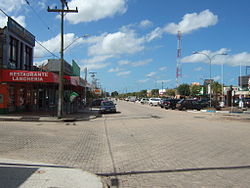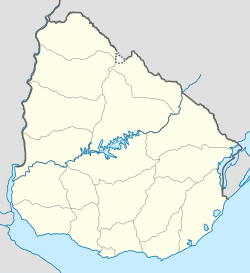Chuy
| Chuy | |
|---|---|
| City | |
 |
|
| Location in Uruguay | |
| Coordinates: 33°41′0″S 53°27′0″W / 33.68333°S 53.45000°WCoordinates: 33°41′0″S 53°27′0″W / 33.68333°S 53.45000°W | |
| Country |
|
| Department | Rocha Department |
| Elevation | 13 m (43 ft) |
| Population (2011) | |
| • Total | 9,675 |
| Time zone | UTC −3 |
| Postal code | 27100 |
| Dial plan | +598 4474 (+4 digits) |
| Climate | Cfa |
Chuy (Spanish pronunciation: [ˈtʃwi]) is a city in the extreme east of Uruguay, in the Rocha Department, 340 kilometres (211 mi) northeast of Montevideo. It lies on the border with Brazil, separated from its Brazilian sister town of Chui only by a shared avenue that serves as the border, and by the Arroyo Chuy (stream) to the east. Chuy's population is currently 9,675 residents as of 2011.
The word "Chuy", according to most scholars, comes from the Tupi–Guarani language. The Indians had designated the small brook on whose banks the town would emerge with the same name. According to Daniel Granada, "Chui" was also the name the Indians gave a yellow-breasted bird, native and common in the marshes of the area. According to Tancredo Blotta, chuy is a compound word which should be translated as "river of brown water".
The Brazilian historian Péricles Azambuja alludes to a rumor that the word (originally Chyu) would have been brought by former tribes who migrated from the Andes. A Quechua word, achuy had the meaning of "teaching" through storytelling, thus chuy'o would be "master " or "narrator." In a different context, chuy can be seen to mean a small frog or toad in the water, a small turtle or small horse. Advocates of some of these theories base their beliefs on the fact that the stream, and watercourse, is insignificant compared to others in the area.
In the late 17th century, Portugal and Spain began the occupation of the Banda Oriental; they succeeded in founding Colonia del Sacramento in 1680, Montevideo in 1726, the Fuerte de San Miguel in 1737, and the Fortaleza de Santa Teresa in 1762. The Treaty of Madrid (1750) settled boundaries between the mouth of the creek Valizas and Cabo Polonio. By order of the Governor of Montevideo, José Joaquín de Viana, in 1751, frontier military posts were created, with colonial guards on both sides of the Chuy stream, the result of the discussions that had prevailed in the courts of the Spanish and Portuguese crowns. The treaty expired in 1761 with the signing of the Treaty of El Pardo. In Europe came the Seven Years' War. At that time, Pedro de Cevallos ousted the Portuguese colony of Santa Teresa and San Miguel, and Chuy came to dominate the southern Rio Grande do Sul. The situation was unstable, however, and the signing of the Treaty of San Ildefonso on October 1, 1777 led to a clearer demarcation of dominions in South America.
...
Wikipedia

